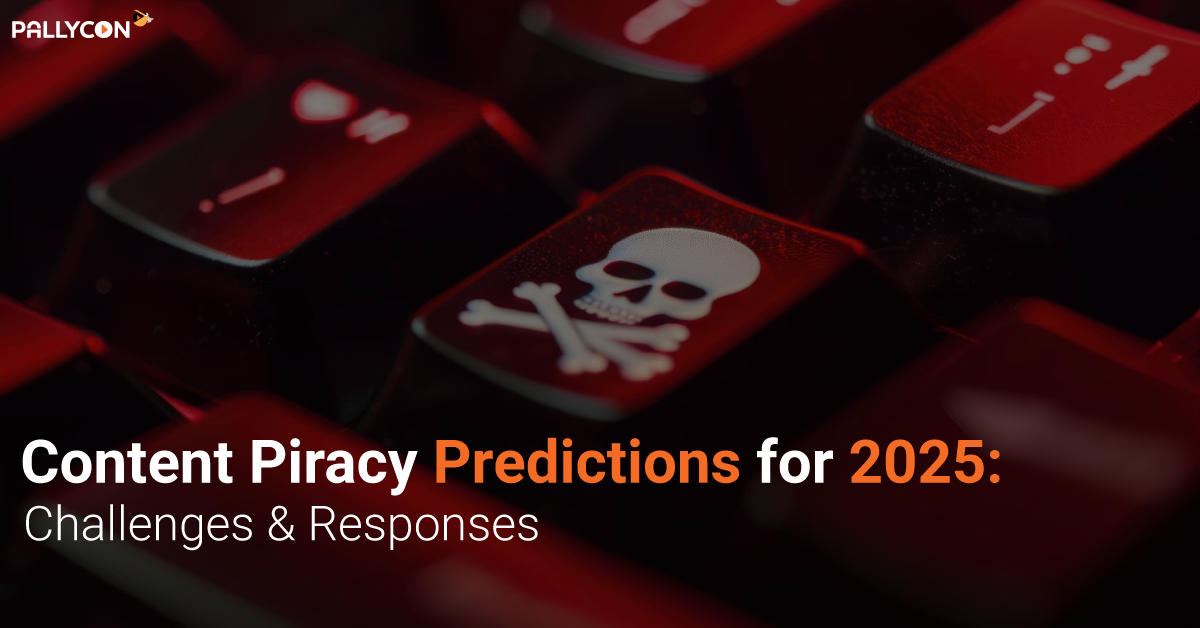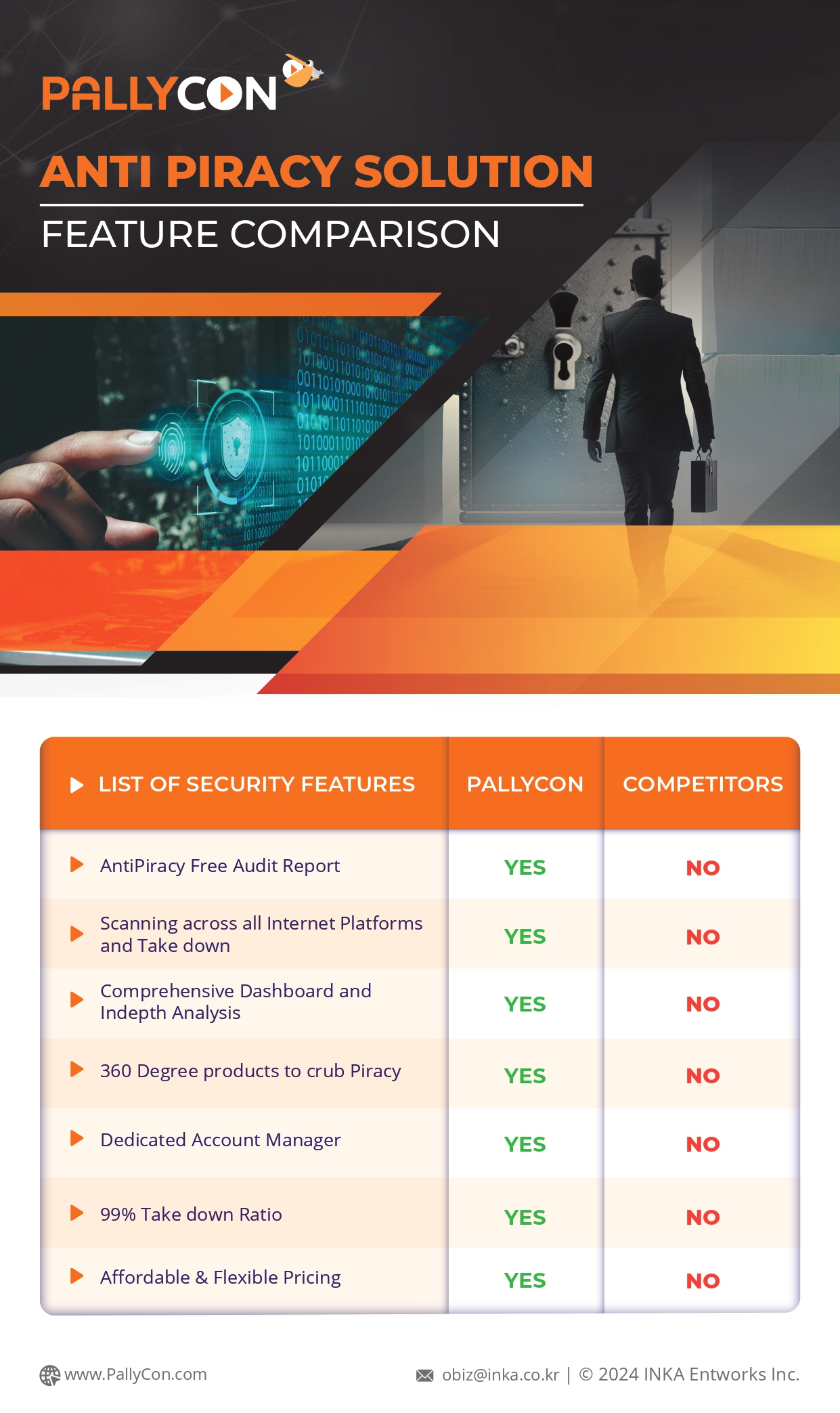
Content Piracy Predictions for 2025: Challenges & Responses
Piracy has been an issue since the early days of video recording, like copying VHS tapes or filming in cinemas. As technology has advanced, piracy has shifted online, becoming more widespread thanks to fast internet and easy-to-use file-sharing tools.
According to a report, online video piracy is costing the global media industry about $75 billion a year in lost revenue. This amount is expected to grow even more, reaching $125 billion by 2028, with piracy increasing annually at nearly 11%.
While laws and regulations help deter piracy, they are not enough. Content Piracy in 2025 or even future years is expected to become more complicated as technology, especially AI, continues to advance. However, content creators can stay ahead by using the right strategies and implementing robust anti-piracy solutions. Companies can take a more active role by offering affordable prices, better access to content, and adhere to standard security mechanisms such as DRM and Forensic Watermarking.
Emerging Threats of Content Piracy in 2025
As we look toward 2025, the landscape of content piracy in 2025 is rapidly evolving, with emerging threats that are driven by advancements in technology. Here is how the threats are evolving and how we can combat piracy.
Rise of AI Technologies
One of the most concerning developments is the rise of AI-powered tools capable of cloning voices, mimicking artistic styles, and generating convincing replicas of copyrighted content. These technologies blur the line between original and pirated content, enabling large-scale reproduction that is difficult to detect and control.
Impact of Content Piracy Across Ecosystem
While piracy traditionally harmed large media corporations, it has now expanded to affect every player in the content creation and distribution ecosystem, including small producers and platforms. For these smaller entities, piracy undermines their ability to earn revenue, stifling creativity and innovation. This creates a vicious cycle where the lack of protection against piracy hinders the growth of new, diverse content, ultimately hurting the industry as a whole.
Consequences of Piracy on the Economy
The economic impact of piracy is also substantial. According to the Motion Picture Association of America, over 122,000 businesses in the U.S. media and entertainment industry are affected, with 92% of them being small companies with fewer than 10 employees. As these businesses suffer, so does the wider economy. Piracy doesn’t just involve casual theft; it is often devised by international criminal groups that engage in a wide range of illegal activities, further destabilizing global markets.
Damage to the Countries Worldwide
Moreover, the reputational damage of piracy extends to countries worldwide. Nations with weak intellectual property protections become less attractive to foreign investors, as the risk of piracy undermines business prospects. In contrast, countries that take strong measures against piracy are ranked higher in influential reports like the Special 301 Report, which evaluates government efforts to protect intellectual property rights.
The Need for Preventing CDN Leaching
A particularly dangerous form of Content piracy in 2025 emerging in this landscape is CDN leeching. This involves pirates hijacking existing Content Delivery Networks (CDNs) to distribute stolen content at little to no cost, bypassing the need to build their own platforms. This new piracy model is especially difficult to detect, as it leverages the same legitimate systems used by trusted services. As streaming and pay-TV platforms continue to compete for larger audiences at lower costs, they are increasingly relying on similar technologies, inadvertently creating common weak points that pirates can exploit.
The Need for Robust Defence Solutions
As more platforms and devices come online, content piracy in 2025 through these compromised systems is expected to grow, posing an even greater challenge to content creators, distributors, and governments alike. The need for stronger technological defences, regulatory action, and international cooperation, along with robust anti-piracy solutions, will become increasingly urgent as the fight against piracy intensifies in the years ahead.
Legal and Ethical Implications
Piracy violates the intellectual property rights of creators, which are the legal protections granted to individuals or organizations for their original works. By distributing or reproducing copyrighted content without authorization, pirates undermine the creator’s exclusive rights, depriving them of the benefits and control over their creations. This infringement disrupts the balance between public access and creator compensation, threatening the sustainability of creative industries.
Legal Consequences of Piracy
- Individuals and organizations caught using pirated content may face civil lawsuits, which can result in hefty fines and compensatory damages to the affected parties.
- In more serious cases, criminal charges may be levied, leading to potential imprisonment.
- These legal consequences are intended to act as deterrents against piracy and protect intellectual property rights.
The Economic Impact of Piracy
According to a report pirated video material gets more than 230 billion views a year. In the United States, digital video piracy alone results in losses ranging between $47.5 and $115.3 billion annually, affecting not only large companies but also smaller businesses within the entertainment industry. These losses reduce profitability and can lead to job cuts, reduced investment, and innovation stagnation within the sector.
Reduced Investment in Original Content
Piracy discourages investment in original content. When companies cannot adequately protect their intellectual property, the financial risks become too high, reducing their incentive to fund new creative projects. This can threaten the long-term growth and diversity of the entertainment industry.
Discouragement of Independent Artists
Finally, piracy discourages independent artists and smaller production houses, who often lack the resources to combat illegal distribution. These creators rely on earnings from their work, and piracy deprives them of fair compensation, stifling their ability to continue producing new content.
Strategies for Fighting Piracy in 2025
Fighting content piracy in 2025 needs a multifaceted strategy that incorporates technology, policy, and public engagement.
-
Advanced Detection Systems
Advanced AI-powered detection systems are pivotal in identifying and removing pirated content swiftly. These systems can scan vast digital landscapes to locate unauthorized reproductions and issue takedown notices automatically.
-
Stakeholder Collaboration
Collaboration between stakeholders is also essential to safeguard content from content theft in 2025. Governments, tech companies, and content creators must work together to establish unified anti-piracy protocols. To combat content piracy in 2025, international agreements can facilitate cross-border enforcement and streamline legal processes against offenders operating from different jurisdictions.
-
Technological Innovations
- Additionally, technological innovations like blockchain can be leveraged to safeguard against content piracy in 2025. Blockchain’s transparent and immutable nature makes it an ideal tool for tracking content ownership and licensing.
- Implementing forensic watermarking helps to trace the source of piracy and disrupt it through blocking or takedown actions, thereby safeguarding reputation and revenue
- Utilizing DRM (Digital Rights Management) to prevent unauthorised recording on playable devices.
-
Content Delivery Network (CDN) Support
CDNs can be employed to revoke pirated streams once they are identified, ensuring quick disruption of unauthorized access.
-
Awareness Campaigns
Education and awareness campaigns targeting consumers play a crucial role. By informing the public about the consequences of piracy and promoting ethical consumption, stakeholders can reduce demand for pirated content.
Ultimately, combating content piracy in 2025 requires a proactive and adaptable approach to stay ahead of increasingly sophisticated pirates.
The Role of Digital Platforms in Content Piracy Prevention
Digital platforms play a critical role in preventing content piracy in 2025. Major platforms have adopted advanced content recognition technologies like forensic watermarking solutions to identify and remove pirated material proactively. Tools like Content ID and AI-driven monitoring systems ensure that copyrighted material is flagged and addressed in real-time.
Platforms also act as gatekeepers, ensuring that uploaded content complies with intellectual property laws. They are increasingly using automated systems to verify ownership before allowing content to be published. Moreover, partnerships with rights holders enable faster response times to takedown requests.
Transparency and accountability are vital to the fight against content theft in 2025. Platforms are implementing clear reporting mechanisms, allowing users to report content piracy in 2025 easily. They are also investing in consumer education initiatives to highlight the importance of respecting intellectual property rights. By taking these measures, digital platforms will not only curb content piracy in 2025 but also foster a safer and more ethical digital ecosystem.
How Content Creators can Protect their Work from Content Piracy in 2025?
Creators can employ video forensic watermarking solutions and Multi DRM solutions to secure their content. These methods make it difficult for pirates to distribute unauthorized copies without detection. Collaborating with legal experts and joining industry associations also empowers creators to take collective action against content piracy in 2025.
Content creators have several tools at their disposal to protect from content piracy in 2025. One effective strategy is leveraging blockchain technology to establish clear proof of ownership. By registering their creations on decentralized ledgers, creators can create tamper-proof records of their intellectual property.
Finally, engaging with audiences directly through exclusive platforms or memberships can reduce reliance on vulnerable distribution channels, thereby reducing the instances of content piracy in 2025. By building strong relationships with their audience, creators can encourage ethical consumption and deter piracy.
FAQs on Content Piracy in 2025
How does piracy affect the global economy?
Piracy significantly impacts the global economy by eroding the revenue streams of creative industries. This leads to job losses, reduced tax revenue, and stifled innovation. It also hampers international trade by making markets less attractive to investors due to weak intellectual property protections.
What role does organized crime play in piracy?
Organized crime syndicates are often involved in piracy, using it as a means to fund other illegal activities. They create networks for distributing pirated content, which can also lead to money laundering, drug trafficking, and human trafficking, making piracy a broader societal issue.
Can piracy affect user privacy?
Yes, piracy often involves unregulated or illegal distribution channels that may expose consumers to malicious software, including viruses, malware, or data breaches. Users who download pirated content from unreliable sources are at increased risk of identity theft or cyberattacks.
What are the ethical implications of using pirated content?
Using pirated content undermines the work and rights of creators, exploiting their intellectual labor without compensation. It also discourages future innovation and creativity, as creators are less motivated to produce new content when their work can be easily stolen.
What steps can content creators take to protect their work from piracy?
Content creators can use anti-piracy services like video DRM, forensic watermarking solutions to trace where their content is distributed illegally and register their works with copyright authorities. They can also consider using blockchain to track ownership and distribution or employ AI-based monitoring systems to detect unauthorized use.

Harish Bhat is a Forensic watermark Product Manager at PallyCon and has been associated with media and broadcasting industry for over 13 years. Apart from technical writing, an avid reader of latest trends in the streaming world and content protection.
